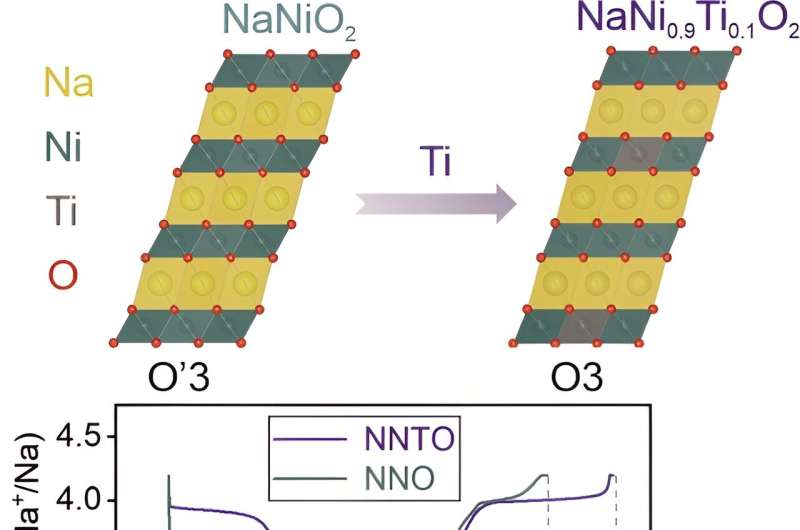
JULY 12, 2024 by Songshan Lake Materials Laboratory
Collected at: https://techxplore.com/news/2024-07-sodium-ion-batteries-titanium-substitution.html
Researchers at Songshan Lake Materials Laboratory have made significant advances in sodium-ion battery (SIB) technology by improving cycling performance of the NaNiO2 cathode. The work has been published in the online edition of Materials Futures.
They successfully synthesized, for the first time, the cathode active material NaNi0.9Ti0.1O2, which delivers a specific capacity of 190 mAh/g, thus positioning it as a potential candidate for application in high-energy-density SIBs. This innovative approach not only improves battery stability but also propels us toward advanced energy-storage solutions beyond.
With its high theoretical specific capacity, NaNiO2 (NNO) shows great potential as an O3-type sodium-ion battery material for beyond lithium energy-storage applications. However, the exchanges of the large Na+ ions can cause severe interlayer sliding and volume changes, reducing cycling performance. Additionally, the Jahn-Teller distortion induced by Ni3+, an uneven arrangement of electrons around the ion’s orbitals, adversely impacts long-term cyclability.
Addressing these issues can significantly enhance the practical application of NNO in the near future.
A research team from Karlsruhe Institute of Technology (KIT) successfully introduced 10 mol% Ti4+ into the Ni site of NNO. This helps to maintain a larger interslab distance in the Na-deficient phases and to mitigate Jahn-Teller activity by reducing the average oxidation state of Ni.
Although NaNi0.9Ti0.1O2 (NNTO) shows significant improvements in cycling performance over NNO, it still faces issues of large volume variations during battery operation and irreversible lattice oxygen loss at high potentials.
These problems lead to structural instability and capacity decay. To address the electro-chemo-mechanical degradation/failure, dopants can be introduced into the Na and/or transition-metal sites of NNTO.
By combining physical and electrochemical characterization techniques, insights into the potential reasons behind the capacity fading of NNTO are gained, offering new avenues for tailoring this promising cathode active material.
The findings are expected to have broad implications for the sodium-ion battery by providing a novel material for high-energy-density, electrochemical energy-storage applications.
More information: Siyu An et al, Improving Cycling Performance of the NaNiO2 Cathode in Sodium-Ion Batteries by Titanium Substitution, Materials Futures (2024). DOI: 10.1088/2752-5724/ad5faa

Leave a Reply